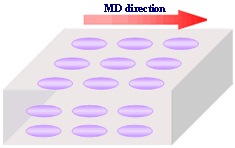Background
Molecules in a liquid crystal polymer film align in a definite direction according to the method in which the film forms. Because the characteristics of the liquid crystal change according to the nature of the arrangement, understanding the organization of liquid crystal molecules is important.
Investigation
Figures 1(a) and 1(b) show the X-ray diffraction profiles in the machine direction (MD) and the transverse direction (TD) for two samples with different processing methods (T-die method and inflation molding method). Figure 1(c) shows the intensity distribution when rotating the sample in the plane for the diffraction peak near 2θ = 20° on Rigaku's Ultima IV multipurpose diffraction system. It is found that the thin-film sample formed with the T-die method has an anisotropic intensity distribution in the sample in-plane direction and has strong diffraction intensities in the MD, showing that there are many liquid crystal molecules facing in the MD.


Furthermore, when combining the results of rocking curve measurements and pole figure measurements, it is possible to imagine that the arrangement of the liquid crystal molecules in the thin film sample formed using the T-die method is as shown in the figure to the right. On the other hand, liquid crystal molecules in the sample formed using the inflation molding method are arranged randomly in all directions.
- When the sample is viewed from the direction of the upper sample plane, many components faces to the MD
- When the sample is viewed from the direction perpendicular to the TD of the sample cross section, many components are parallel to the sample surface.
